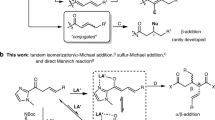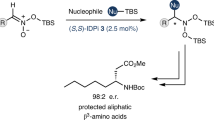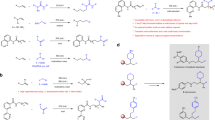Abstract
The reactions of acyl anion equivalents (d1 synthons) with carbonyl electrophiles allow for the construction of a wide range of molecules useful for the synthesis of biologically active compounds, natural products and chiral ligands. Despite their utility, significant challenges still exist for developing catalytic, enantioselective variants of these reactions. For example, the asymmetric benzoin process, arguably the most characteristic reaction of d1 synthetic equivalents, finds no general solution for reactions involving aliphatic acyl anions. In this Article, we introduce a new class of stable, isolable silyl ketene imines derived from protected cyanohydrins. These nucleophiles serve as acyl anion equivalents in Lewis base catalysed aldol addition reactions and allow for the preparation of cross-benzoin and glycolate-aldol products in high yield and with exceptional diastereo- and enantioselectivities.
This is a preview of subscription content, access via your institution
Access options
Subscribe to this journal
Receive 12 print issues and online access
$259.00 per year
only $21.58 per issue
Buy this article
- Purchase on Springer Link
- Instant access to full article PDF
Prices may be subject to local taxes which are calculated during checkout




Similar content being viewed by others
References
Stork, G. & Maldonado, L. Anions of protected cyanohydrins as acyl carbanion equivalents and their use in a new synthesis of ketones. J. Am. Chem. Soc. 93, 5286–5287 (1971).
Hünig, S. & Wehner, G. Nucleophile acylation with masked acyl anions; III. Synthesis of alpha-hydroxy ketones. Synthesis 391–392 (1975).
Hünig, S. & Wehner, G. Nucleophilic acylation with masked acyl anions II. Synthesis 180–182 (1975).
Deuchert, K., Hertenstein, U. & Hünig, S. Nucleophilic acylation with masked acyl anions. Synthesis 777–778 (1973).
Albright, J. D. Reactions of acyl anion equivalents derived from cyanohydrins, protected cyanohydrins and alpha-dialkylaminonitriles. Tetrahedron 39, 3207–3233 (1983).
Schrader, T. Stereoselective umpolung reactions with metalated P-chiral cyanohydrin phosphates — enantioselective synthesis of tertiary cyanohydrins. Chem. Eur. J. 3, 1273–1282 (1997).
Brook, A. G. Some molecular rearrangements of organosilicon compounds. Acc. Chem. Res. 7, 77–84 (1974).
Moser, W. H. The Brook rearrangement in tandem bond formation strategies. Tetrahedron 57, 2065–2084 (2001).
Deglinnocenti, A., Ricci, A., Mordini, A., Reginato, G. & Colotta, V. Acylsilane-mediated nucleophilic acylation of alpha,beta-unsaturated carbonyl derivatives. Gazz. Chim. Ital. 117, 645–648 (1987).
Reich, H. J., Holtan, R. C. & Bolm, C. Acylsilane chemistry — synthesis of regioisomerically and stereoisomerically defined enol silyl ethers using acylsilanes. J. Am. Chem. Soc. 112, 5609–5617 (1990).
Takeda, K. & Ohnishi, Y. Reaction of acylsilanes with potassium cyanide: Brook rearrangement under phase-transfer catalytic conditions. Tetrahedron Lett. 41, 4169–4172 (2000).
Linghu, X. & Johnson, J. S. Kinetic control in direct alpha-silyloxy ketone synthesis: a new regiospecific catalyzed cross silyl benzoin reaction. Angew. Chem. Int. Ed. 42, 2534–2536 (2003).
Linghu, X., Bausch, C. C. & Johnson, J. S. Mechanism and scope of the cyanide-catalyzed cross silyl benzoin reaction. J. Am. Chem. Soc. 127, 1833–1840 (2005).
Nicewicz, D. A., Yates, C. M. & Johnson, J. S. Catalytic asymmetric acylation of (silyloxy)nitrile anions. Angew. Chem. Int. Ed. 43, 2652–2655 (2004).
Nicewicz, D. A., Yates, C. M. & Johnson, J. S. Enantioselective cyanation/Brook rearrangement/C-acylation reactions of acylsilanes catalyzed by chiral metal alkoxides. J. Org. Chem. 69, 6548–6555 (2004).
Linghu, X., Potnick, J. R. & Johnson, J. S. Metallophosphites as umpolung catalysts: the enantioselective cross silyl benzoin reaction. J. Am. Chem. Soc. 126, 3070–3071 (2004).
Dunkelmann, P. et al. Development of a donor−acceptor concept for enzymatic cross-coupling reactions of aldehydes: the first asymmetric cross-benzoin condensation. J. Am. Chem. Soc. 124, 12084–12085 (2002).
Giampietro, N. C., Kampf, J. W. & Wolfe, J. P. Asymmetric tandem Wittig rearrangement/aldol reactions. J. Am. Chem. Soc. 131, 12556–12557 (2009).
Misaki, T., Takimoto, G. & Sugimura, T. Direct asymmetric aldol reaction of 5H-oxazol-4-ones with aldehydes catalyzed by chiral guanidines. J. Am. Chem. Soc. 132, 6286–6287 (2010).
Manthorpe, J. M. & Gleason, J. L. Stereoselective generation of E- and Z-disubstituted amide enolates. Reductive enolate formation from bicylic thioglycolate lactams. J. Am. Chem. Soc. 123, 2091–2092 (2001).
Das, J. P., Chechik, H. & Marek, I. A unique approach to aldol products for the creation of all-carbon quaternary stereocentres. Nature Chem. 1, 128–132 (2009).
Kobayashi, S. & Horibe, M. Chiral Lewis acid controlled synthesis (CLAC synthesis): chiral Lewis acids influence the reaction course in asymmetric aldol reactions for the synthesis of enantiomeric dihydroxythioester derivatives in the presence of chiral diamines derived from L-proline. Chem. Eur. J. 3, 1472–1481 (1997).
Denmark, S. E. & Chung, W. J. Lewis base activation of Lewis acids: catalytic enantioselective glycolate aldol reactions. Angew. Chem. Int. Ed. 47, 1890–1892 (2008).
Denmark, S. E. & Chung, W. J. Lewis base activation of Lewis acids: catalytic, enantioselective addition of glycolate-derived silyl ketene acetals to aldehydes. J. Org. Chem. 73, 4582–4595 (2008).
Denmark, S. E., Wilson, T. W., Burk, M. T. & Heemstra, J. R. Enantioselective construction of quaternary stereogenic carbons by the Lewis base catalyzed additions of silyl ketene imines to aldehydes. J. Am. Chem. Soc. 129, 14864–14865 (2007).
Mermerian, A. H. & Fu, G. C. Nucleophile-catalyzed asymmetric acylations of silyl ketene imines: application to the enantioselective synthesis of verapamil. Angew. Chem. Int. Ed. 44, 949–952 (2005).
Cunico, R. F. & Kuan, C. P. On the metalation silylation of O-trimethylsilyl aldehyde cyanohydrins. J. Org. Chem. 57, 1202–1205 (1992).
Dinizo, S. E., Freerksen, R. W., Pabst, W. E. & Watt, D. S. Synthesis of alpha-alkoxyacrylonitriles using substituted diethyl cyanomethylphosphonates. J. Org. Chem. 41, 2846–2849 (1976).
Krimen, L. I. & Cota, D. J. Ritter reaction. Org. React. 17, 213–325 (1969).
Watt, D. S. The silylation of nitrile anions — silyl ketene imines. Synth. Commun. 4, 127–132 (1974).
Watt, D. S. Oxidative decyanation of arylacetonitriles — synthesis of ligusticumic acid. J. Org. Chem. 39, 2799–2800 (1974).
Belousova, L. I., Kruglaya, O. A., Kalikhman, I. D. & Vyazankin, N. S. Alpha-germylated nitriles. J. Gen. Chem. USSR 51, 678–683 (1981).
Denmark, S. E. & Heemstra, J. R. Lewis base activation of Lewis acids. Vinylogous aldol addition reactions of conjugated N,O-silyl ketene acetals to aldehydes. J. Am. Chem. Soc. 128, 1038–1039 (2006).
Denmark, S. E. & Wynn, T. Lewis base activation of Lewis acids: catalytic enantioselective allylation and propargylation of aldehydes. J. Am. Chem. Soc. 123, 6199–6200 (2001).
Denmark, S. E. & Heemstra, J. R. Lewis base activation of Lewis acids. Catalytic enantioselective addition of silyl enol ethers of achiral methyl ketones to aldehydes. Org. Lett. 5, 2303–2306 (2003).
Denmark, S. E. & Fan, Y. Catalytic, enantioselective alpha-additions of isocyanides: Lewis base catalyzed Passerini-type reactions. J. Org. Chem. 70, 9667–9676 (2005).
Denmark, S. E., Beutner, G. L., Wynn, T. & Eastgate, M. D. Lewis base activation of Lewis acids: catalytic, enantioselective addition of silyl ketene acetals to aldehydes. J. Am. Chem. Soc. 127, 3774–3789 (2005).
Denmark, S. E. & Beutner, G. L. Lewis base activation of Lewis acids. Vinylogous aldol reactions. J. Am. Chem. Soc. 125, 7800–7801 (2003).
Denmark, S. E. & Heemstra, J. R. Lewis base activation of Lewis acids: catalytic, enantioselective vinylogous aldol addition reactions. J. Org. Chem. 72, 5668–5688 (2007).
Denmark, S. E. & Beutner, G. L. Lewis base catalysis in organic synthesis. Angew. Chem. Int. Ed. 47, 1560–1638 (2008).
Denmark, S. E. & Wilson, T. W. Construction of quarternary stereogenic carbon centers by the Lewis base catalyzed conjugate addition of silyl ketene imines to α,β-unsaturated aldehydes and ketones. Synlett. 1723–1728 (2010).
Larock, R. C. Comprehensive Organic Transformations 2nd edn (Wiley-VCH, 1999).
Patai, S. The Chemistry of Triple-Bonded Functional Groups (Wiley-VCH, 1994).
Manetto, A. et al. Independent generation of C5’-nucleosidyl radicals in thymidine and 2’-deoxyguanosine. J. Org. Chem. 72, 3659–3666 (2007).
Denmark, S. E., Eklov, B. M., Yao, P. J. & Eastgate, M. D. On the mechanism of Lewis base catalyzed aldol addition reactions: kinetic and spectroscopic investigations using rapid-injection NMR. J. Am. Chem. Soc. 131, 11770–11787 (2009).
Conceicao, G. J. A., Moran, P. J. S. & Rodrigues, J. A. R. Highly efficient extractive biocatalysis in the asymmetric reduction of an acyclic enone by the yeast Pichia stipitis. Tetrahedron Asymm. 14, 43–45 (2003).
Acknowledgements
The authors are grateful to the National Science Foundation (NSF CHE-0414440 and 0717989) for financial support. T.W.W. thanks Abbott Laboratories for a Graduate Fellowship in Synthetic Organic Chemistry.
Author information
Authors and Affiliations
Contributions
T.W.W. planned and carried out the experimental work. S.E.D. initiated and directed the project. The manuscript was written jointly by the authors.
Corresponding author
Ethics declarations
Competing interests
The authors declare no competing financial interests.
Supplementary information
Supplementary information
Supplementary information (PDF 2104 kb)
Supplementary information
Crystallographic data for compound 6da (CIF 20 kb)
Rights and permissions
About this article
Cite this article
Denmark, S., Wilson, T. N-silyl oxyketene imines are underused yet highly versatile reagents for catalytic asymmetric synthesis. Nature Chem 2, 937–943 (2010). https://doi.org/10.1038/nchem.857
Received:
Accepted:
Published:
Issue Date:
DOI: https://doi.org/10.1038/nchem.857
This article is cited by
-
Natural polarity inverted
Nature (2015)



